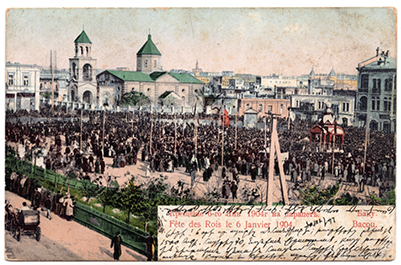 Baku’s Christians celebrate Christmas on 6th January at the beginning of the 20th century. The Armenian church of St Gregory the Illuminator is shown here
Baku’s Christians celebrate Christmas on 6th January at the beginning of the 20th century. The Armenian church of St Gregory the Illuminator is shown here
Armenian Genocide Museum-Institute
The Young Turks’ WWI genocidal policy was not limited to the massacres and forced deportations of western Armenians during 1915-1923. It was also implemented against eastern Armenians between 1918 to 1920, when the Armenians of Baku province were massacred and deported by Turkey and Musavat Azerbaijan. After the failures of the 3rd and 4th Turkish army divisions in the battles of Sardarapat and Bash Aparan in May 1918 and the capture of Gharakilisa, the 2nd Turkish division advanced on Baku on a line through Jajur-Hamamlu-Gharakilisa-Dilijan-Ghazakh-Elizavetpol. The entry of the Turks into Baku was greatly aided by the newly-formed Musavat government of the Democratic Republic of Azerbaijan in Gandzak (headed by M. Fatali Khan-Khoyski).
Turkish-Musavat cooperation became more obvious when the commander-in-chief of the Caucasus Turkish Army, Lieutenant General Nuri Pasha arrived in Gandzak from Mosul on May 27. During a secret meeting held in Gandzak between the Azerbaijani government and Musavat party figures in May 1918, plans were developed for massacres of Armenians in the provinces of Nukhi, Aresh, Gyokcha, Shamakh and Baku. The secret order concerning this issued by the Minister of Internal Affairs of the Republic of Azerbaijan Behbud Khan-Jivanshir to the mayors of Nukhi, Shamakh and Baku before the massacres is remarkable, and stated:
“It is necessary to annihilate the Armenians in order to achieve our goals of crossing over their corpses. Do not spare anyone and follow the instructions given to you faithfully.”
Turkish troops launched military operations on Baku on June 15. The operations were accompanied by massacres of the local Armenian population. Under these conditions, the Armenians of Baku resorted to self-defense in order to maintain their physical existence. Sebastatsi Murad (Murad Khrimyan), Sepuh (Arshak Nersisyan) and Stepan Tsaghikyan quickly came to the Baku defenders’ aid from the northern Caucasus. In the heroic battles of the first days of August, however, Sebastatsi Murad was killed, but the Baku self-defense forces were able to prevent the enemy’s advance at the cost of suffering heavy losses. Baku was completely surrounded by land within a month, maintaining contact with the outside world only via the Caspian Sea. Despite the overwhelming advantage held by the Turkish-Tatar forces, the defense of Baku lasted until September 14. Thanks to their stubborn battles, the defenders managed to gain time to move the Armenian population out of the city.
It was only possible to relocate 50,000 of Baku’s Armenian population of 100,000. At 12 o’clock on September 15, Turkish troops broke into the city. Although Mursel Pasha, on behalf of Nuri Pasha, had given “guarantees for the security of the civil population and of property” to local and international bodies, Turkish-Tatar bandits, led by Turkish officers, brutally massacred 30,000 Armenians in three days (September 15-17).
In the city of Baku (formerly the province of Baku) the Turkish regular army and Tatar bandits continue the genocide of Armenians that took place in the Armenian-populated areas of the Ottoman Empire.
 Excerpt from the newspaper "Mer-Orer" published in Baku, December 1918.
Excerpt from the newspaper "Mer-Orer" published in Baku, December 1918.





